North America hosts some of the most magnificent birds of prey on the planet. These aerial hunters, collectively known as raptors, command the skies with unparalleled precision, power, and adaptability. From the dense forests of the Pacific Northwest to the open plains of the Midwest and the coastal marshes of the Atlantic, seven species in particular have established themselves as the undisputed apex predators of North American skies. These birds have evolved remarkable physical characteristics and hunting strategies that make them perfectly suited for their roles as nature’s airborne assassins. Their keen eyesight, powerful talons, and hooked beaks are just a few of the adaptations that have allowed them to thrive across diverse ecosystems. Join us as we explore these magnificent birds of prey that have captured human imagination for centuries while maintaining crucial roles in their respective ecosystems.
The Bald Eagle: America’s National Symbol
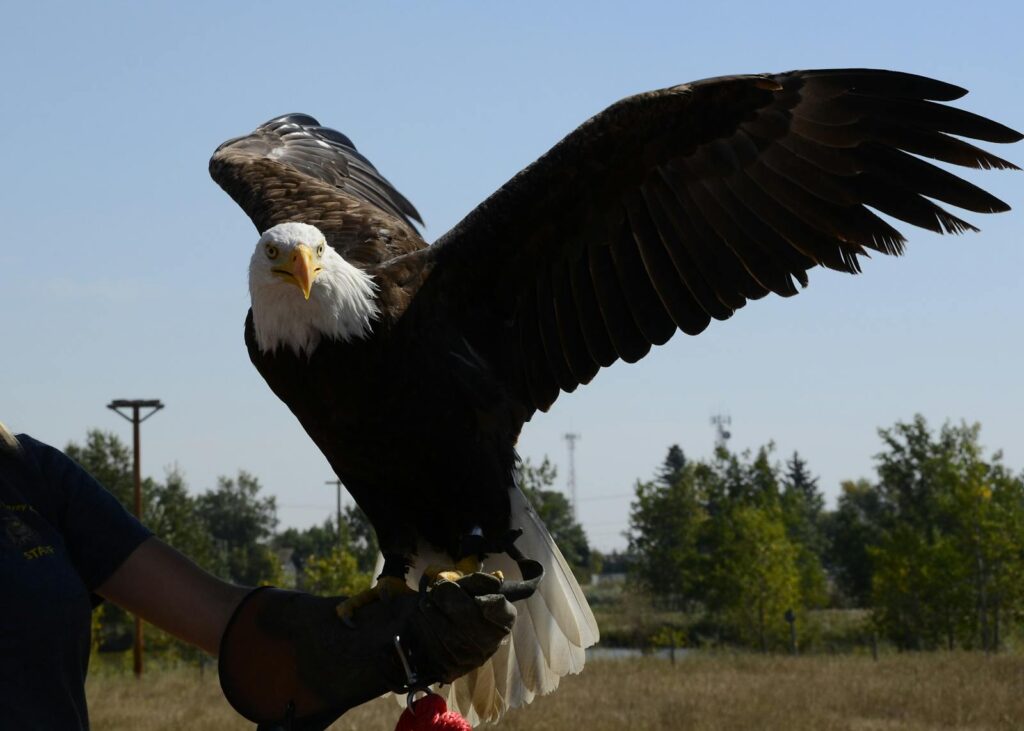
No discussion of North American raptors would be complete without first acknowledging the iconic Bald Eagle (Haliaeetus leucocephalus), which has served as the national symbol of the United States since 1782. With its distinctive white head and tail contrasting against a dark brown body and wingspan reaching up to 7.5 feet, this majestic bird commands attention wherever it appears. Primarily fish eaters, Bald Eagles are commonly found near bodies of water where they employ their remarkable vision—estimated to be four to seven times more powerful than human eyesight—to spot prey from considerable distances. Once endangered due to habitat destruction and DDT poisoning, Bald Eagles represent one of America’s greatest conservation success stories, having rebounded from just 417 nesting pairs in the 1960s to more than 71,400 nesting pairs today. Beyond their role as national symbols, these birds form monogamous pairs that often mate for life, building some of the largest nests in the bird world—structures that can weigh up to a ton and measure 8 feet across.
The Golden Eagle: Ruler of the Western Wilderness
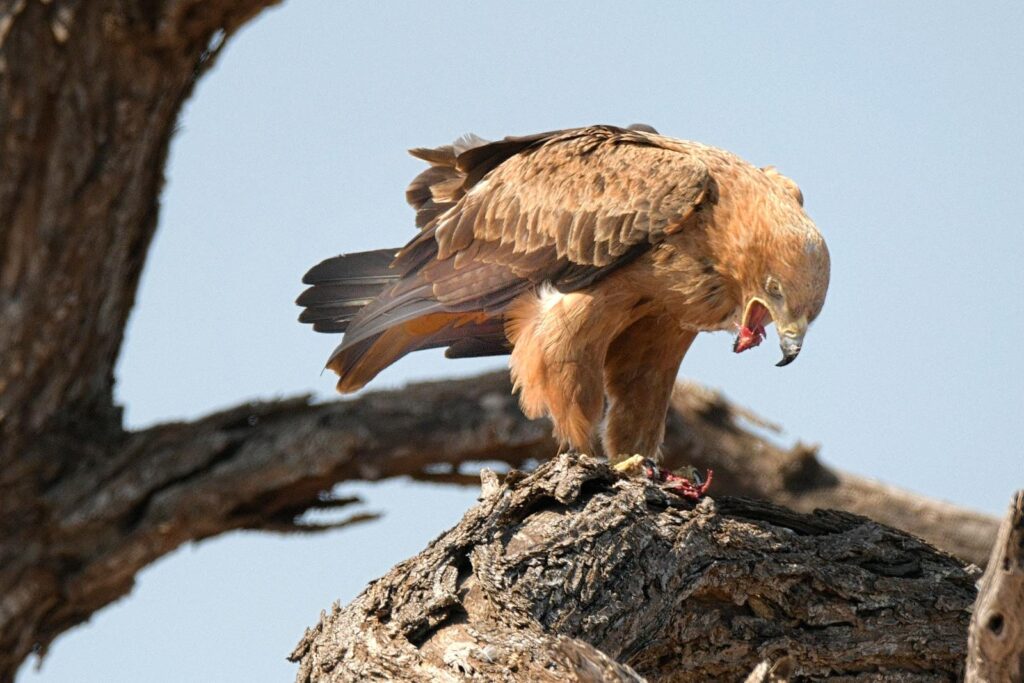
The Golden Eagle (Aquila chrysaetos) stands as one of North America’s largest and most powerful birds of prey, predominantly inhabiting the mountainous regions and open country of western North America. Distinguished by their dark brown plumage and golden nape feathers that give them their name, these magnificent birds boast wingspans of up to 7.5 feet and can dive at speeds exceeding 150 miles per hour when hunting. Unlike their Bald Eagle cousins, Golden Eagles are terrestrial predators that primarily target mammals such as rabbits, ground squirrels, and even larger prey like young deer or coyote pups, demonstrating hunting prowess that has earned them reverence among many indigenous cultures. Their exceptional strength allows them to carry prey weighing up to their own body weight, a feat that few other raptors can accomplish. Golden Eagles form lifelong pair bonds and often maintain several nests within their territory, rotating between them across breeding seasons while fiercely defending territories that can span over 60 square miles.
The Peregrine Falcon: Speed Demon of the Skies

The Peregrine Falcon (Falco peregrinus) holds the distinguished title of the fastest animal on Earth, capable of reaching speeds over 240 mph during its signature hunting dive known as the “stoop.” This medium-sized raptor, featuring a distinctive black “mustache” mark against slate-gray back and barred underparts, has adapted to diverse habitats across North America, from coastal cliffs to urban skyscrapers that mimic their natural cliff-dwelling preferences. Specialized adaptations for high-speed flight include streamlined bodies, stiff feathers, and even special bony tubercles in their nostrils that control airflow during dives, allowing them to breathe while traveling at speeds that would suffocate most birds. Peregrines primarily hunt other birds, from small songbirds to waterfowl and pigeons, striking them mid-air with a closed foot, delivering an impact that often kills prey instantly. Like Bald Eagles, Peregrine Falcons suffered catastrophic population declines due to DDT but have made a remarkable recovery through intensive conservation efforts, including urban reintroduction programs that have established thriving populations in cities across the continent.
The Red-tailed Hawk: Ubiquitous Roadside Hunter
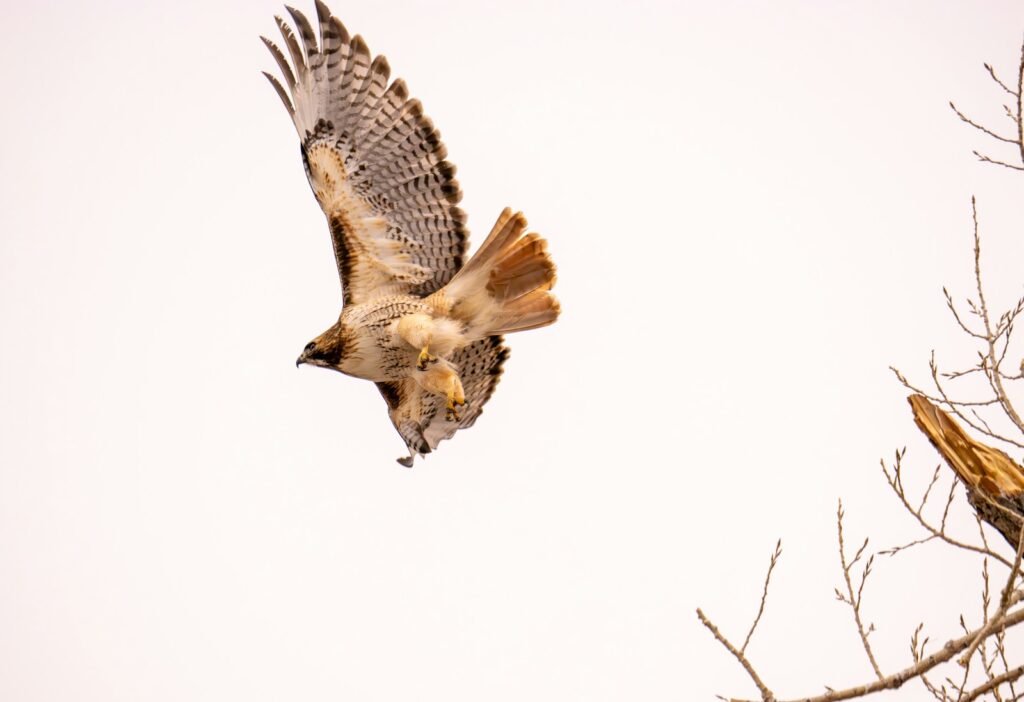
Perhaps the most frequently observed raptor in North America, the Red-tailed Hawk (Buteo jamaicensis) has successfully adapted to nearly every habitat on the continent, from desert scrublands to dense forests and increasingly urban environments. Easily identified by their rich, reddish-brown tails and bulky build, these versatile predators display remarkable variation in plumage patterns across their range, with fourteen recognized subspecies exhibiting colors from pale to nearly black. Their hunting strategy typically involves perching prominently on utility poles, fence posts, or trees while scanning open areas for prey, primarily consisting of small to medium-sized mammals like rabbits, squirrels, and voles. The characteristic raspy scream of the Red-tailed Hawk has become Hollywood’s standard “eagle call,” frequently dubbed over footage of other raptors in films and television programs. Adaptable and resilient, Red-tailed Hawks have maintained stable populations despite habitat changes, demonstrating remarkable flexibility in nesting locations and prey selection that has allowed them to thrive while other raptor species struggle.
The Great Horned Owl: Nocturnal Tyrant
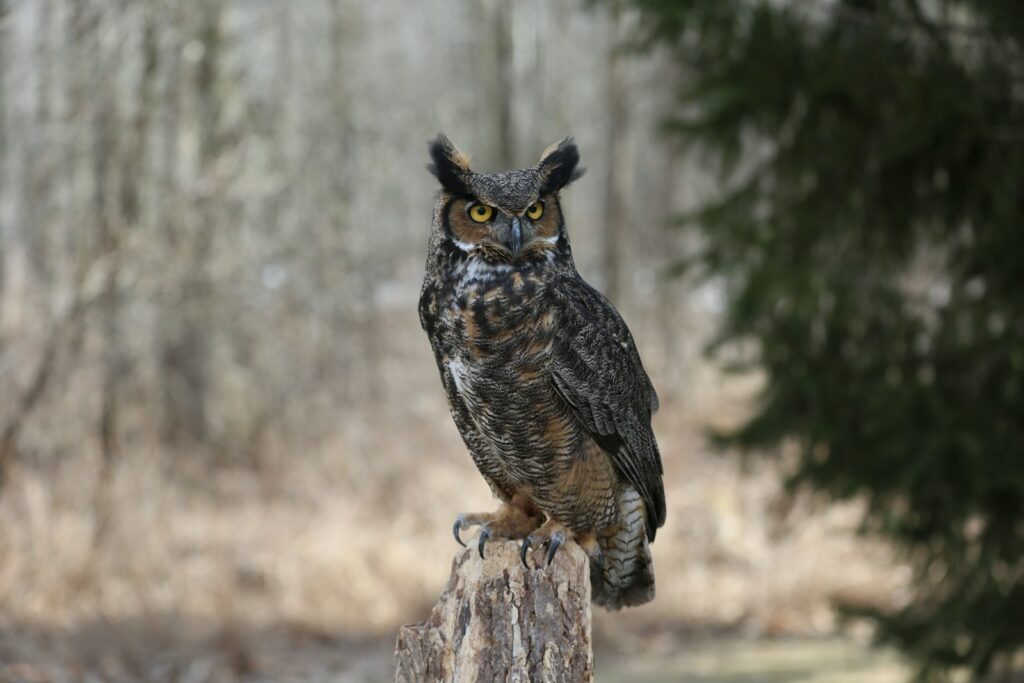
The Great Horned Owl (Bubo virginianus) reigns supreme as North America’s most formidable nocturnal predator, distinctive for its large size, prominent ear tufts (which aren’t actually ears), and intimidating yellow eyes. Distributed across nearly every habitat from the Arctic tundra to desert regions and suburban woodlots, these powerful owls have earned the nickname “tiger of the sky” for their fearsome hunting abilities and willingness to tackle prey ranging from tiny mice to animals as large as skunks, house cats, and even other raptors. Their specialized adaptations for night hunting include asymmetrical ear positions that allow for precise sound triangulation, serrated feather edges that enable silent flight, and exceptional low-light vision approximately 100 times more sensitive than human eyes. Great Horned Owls are among the earliest nesting birds in North America, often laying eggs in January or February, even in northern regions where snow still blankets their territories. As one of the few predators willing to hunt skunks, these owls often carry the distinctive musky scent of their prey, earning them yet another nickname among researchers: “flying skunks.”
The Osprey: The Fish Hawk
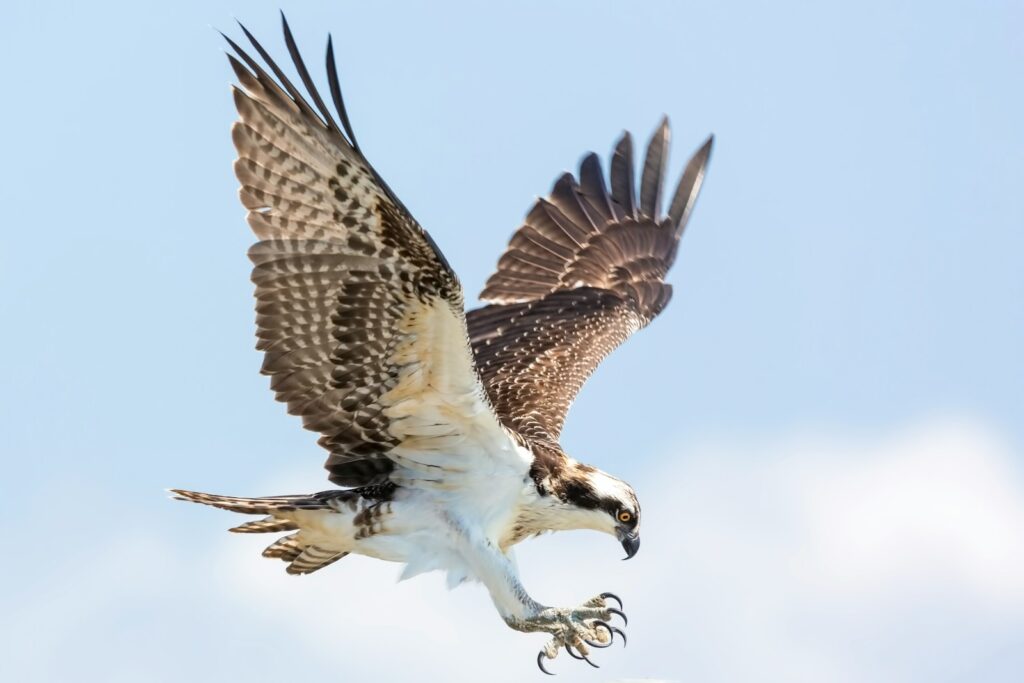
The Osprey (Pandion haliaetus) has evolved as one of the most specialized raptors on the planet, with adaptations perfectly suited for its nearly exclusive fish diet, earning it the common name “fish hawk.” Easily recognized by their white underparts, dark brown upperparts, and distinctive dark eye stripe, Ospreys possess unique physical characteristics including reversible outer toes, specialized barbed foot pads, and dense, oily plumage that allows them to plunge feet-first into water and emerge with their catch. Their hunting success rate is remarkably high—approximately 70 percent—making them among the most efficient fishers in the raptor world. Ospreys build conspicuous stick nests on elevated platforms, often on human-made structures like utility poles, channel markers, and purpose-built nesting platforms, which has helped their recovery following DDT-related declines. Highly migratory, North American Ospreys travel thousands of miles each year between breeding grounds across the continent and wintering areas primarily in Central and South America, with some individuals documented making round trips exceeding 5,000 miles annually.
The Northern Goshawk: Phantom of the Forest
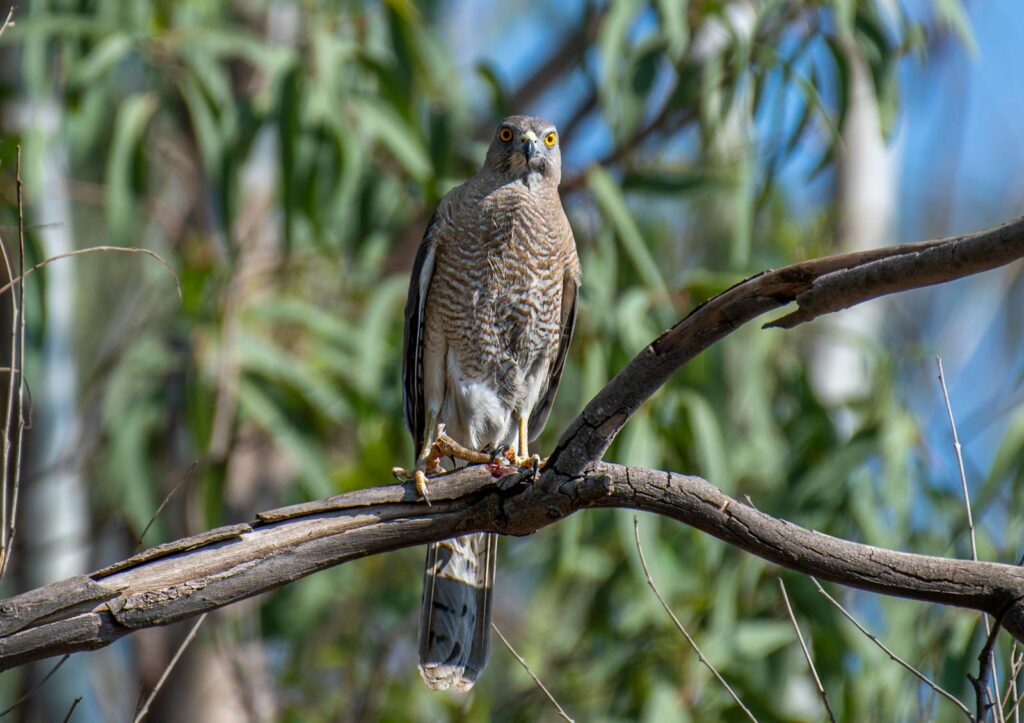
The Northern Goshawk (Accipiter gentilis) represents the largest and most powerful member of the Accipiter genus in North America, a group characterized by short, rounded wings and long tails that enable remarkable maneuverability through dense forest environments. With steel-gray upperparts, finely barred light underparts, and a distinctive white eyebrow, these secretive forest hunters maintain an almost mythical status among birders due to their elusive nature and preference for mature forest habitats far from human disturbance. Northern Goshawks employ a hunting strategy known as “still-hunting,” where they perch quietly within the forest canopy before launching explosive, high-speed pursuits through dense vegetation to capture woodland prey including squirrels, rabbits, grouse, and jays. Their fierce defensive behavior around nesting sites has earned them a fearsome reputation—they’ve been known to strike humans who venture too close to their nests, sometimes drawing blood with their powerful talons. Revered in falconry for over a thousand years and considered the “cook’s hawk” in medieval Europe for their ability to provide game for the table, goshawks continue to face threats from logging practices that fragment their preferred mature forest habitats.
Evolutionary Adaptations for Aerial Dominance
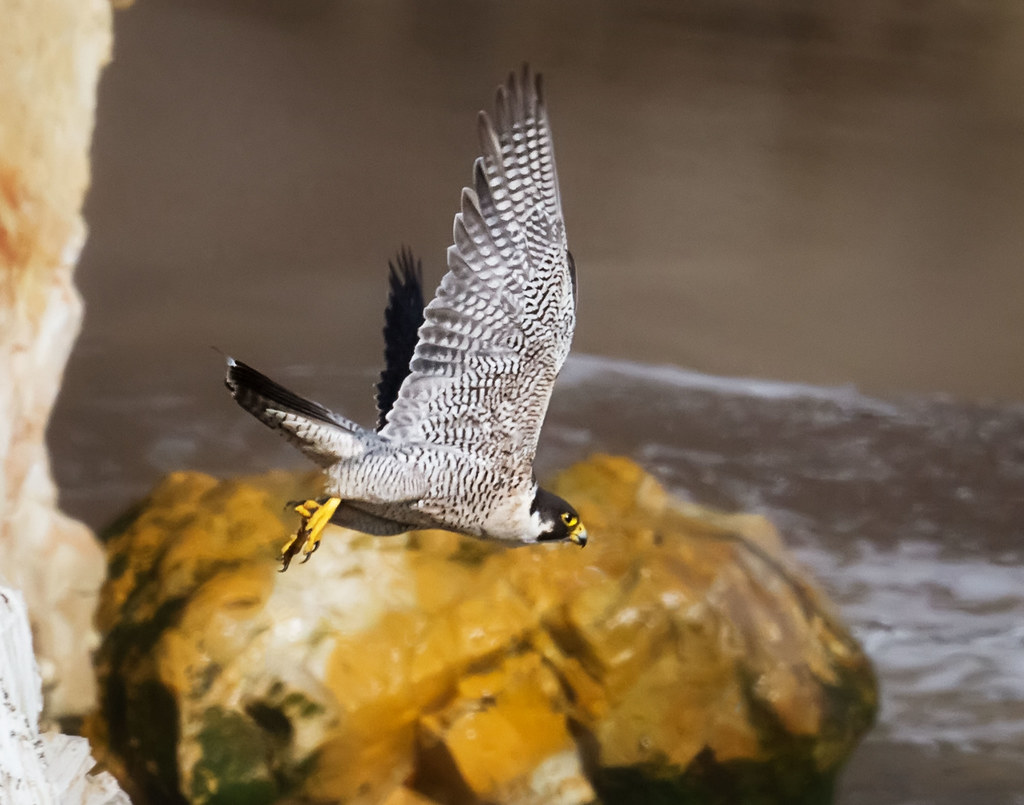
North American raptors have evolved an impressive array of specialized adaptations that allow them to excel as aerial predators across diverse environments. Their exceptional vision stands as perhaps their most remarkable feature—many species can spot small prey from over a mile away and perceive ultraviolet light invisible to humans, allowing them to track urine trails of rodents or see distinctive patterns on prey that aid in hunting. The hooked beaks characteristic of all raptors serve as efficient tools for tearing flesh, while their powerful feet and talons function as deadly weapons capable of exerting tremendous pressure—Peregrine Falcons can strike with force exceeding 25 times their body weight. Specialized wing shapes reflect different hunting strategies: the broad wings of buteos like Red-tailed Hawks provide efficient soaring abilities, while the long, narrow wings of falcons enable exceptional speed, and the short, rounded wings of accipiters allow for agile forest maneuvering. Additional adaptations include specialized respiratory systems that enable high-altitude flight, crop storage that allows consumption of large amounts of food when available, and remarkable metabolic efficiency that helps them survive periods of food scarcity.
Ecological Roles and Importance
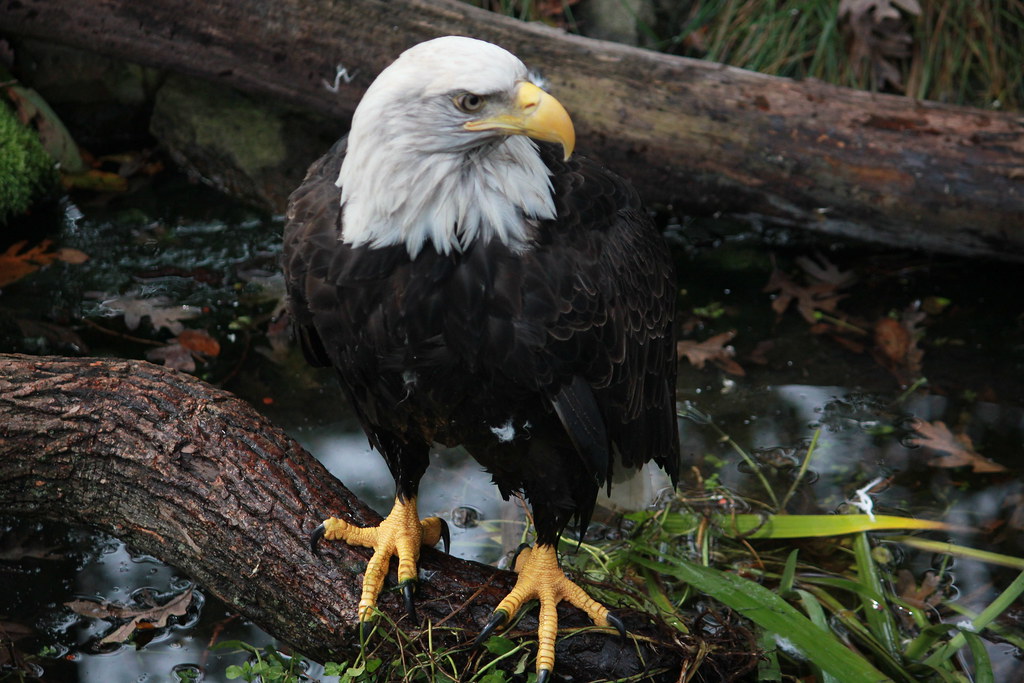
As apex predators, North America’s dominant raptors play crucial roles in maintaining ecological balance within their respective ecosystems through both direct and indirect interactions. By controlling populations of small mammals, birds, and in some cases reptiles and fish, these aerial hunters help prevent potential ecological imbalances that could occur if prey species became overabundant. Many raptor species serve as important biological indicators—their presence and breeding success often reflect overall ecosystem health, making them valuable subjects for environmental monitoring programs. Some species provide important ecosystem services through scavenging behavior—Bald Eagles, for instance, clean up dead fish and other carcasses along waterways, potentially reducing disease transmission. Their nesting behaviors can create habitat for other species, as abandoned raptor nests are frequently utilized by other birds and mammals for shelter and breeding. Additionally, raptors’ position at the top of food chains makes them particularly vulnerable to environmental contaminants, allowing them to serve as early warning systems for detecting harmful pollutants before they affect broader ecosystems.
Conservation Challenges and Successes
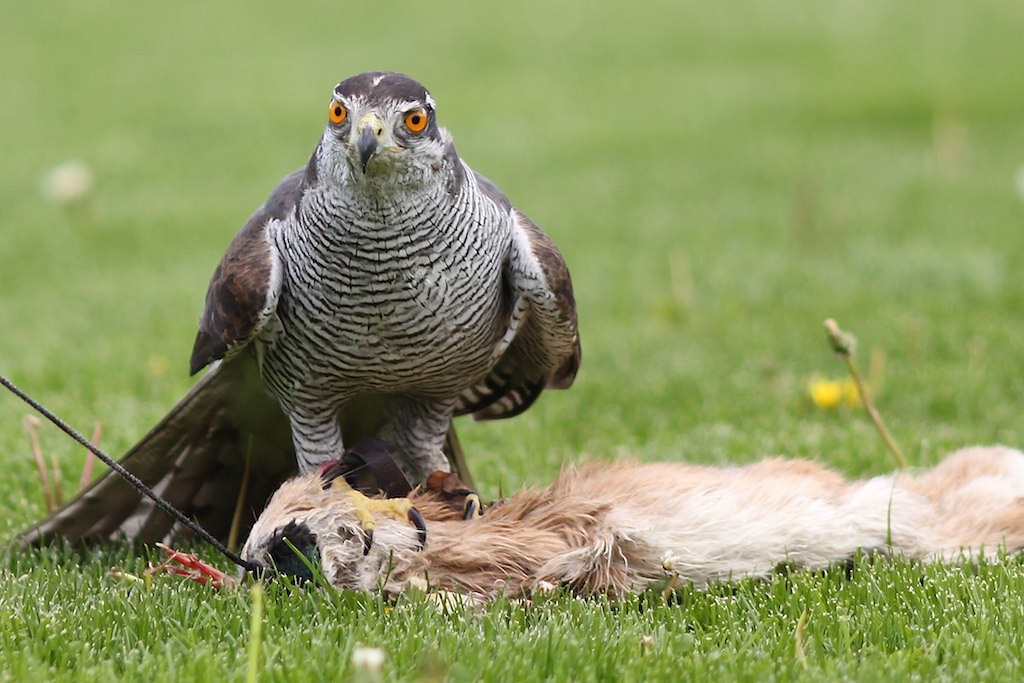
North American raptors have faced numerous conservation challenges throughout the 20th and 21st centuries, with widespread DDT use from the 1940s to 1972 causing catastrophic population declines in many species, particularly those that fed primarily on fish and aquatic birds. Habitat loss continues to threaten many species, especially forest specialists like Northern Goshawks that require large tracts of mature woodland, while wind energy development has emerged as a more recent threat through direct collisions with turbines. Lead poisoning remains a significant issue for scavenging species that consume hunter-discarded gut piles containing lead fragments or wounded prey that escape with lead ammunition still embedded. Despite these challenges, raptor conservation represents one of wildlife management’s greatest success stories, with species like the Bald Eagle, Peregrine Falcon, and Osprey recovering from the brink of extinction through concerted conservation efforts including habitat protection, captive breeding programs, and regulatory changes like the ban on DDT. Ongoing conservation efforts focus on addressing emerging threats like climate change while continuing to monitor populations and protect critical habitats for these iconic aerial predators.
Cultural Significance and Human Connections
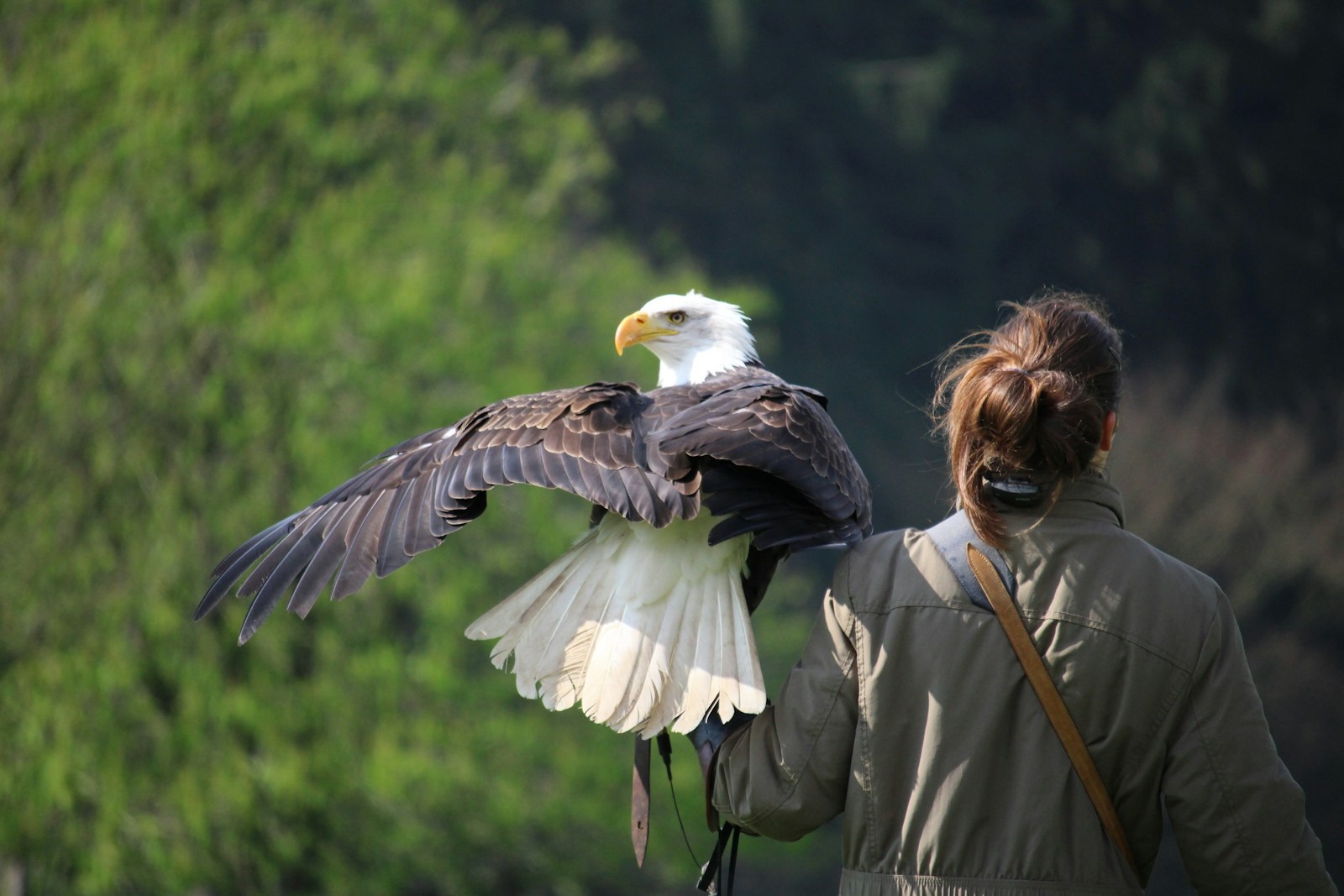
Throughout human history, raptors have occupied a special place in North American cultural traditions, appearing prominently in indigenous art, stories, and spiritual practices across the continent. The Bald Eagle’s selection as the national symbol of the United States in 1782 reflects the long-standing human fascination with these birds, chosen for qualities including strength, freedom, and long life. In falconry, one of the world’s oldest field sports dating back over 4,000 years, species like the Peregrine Falcon, Northern Goshawk, and Red-tailed Hawk continue to partner with human hunters in a unique relationship that has generated specialized knowledge about raptor behavior and biology. Modern wildlife photography, birding, and educational programming centered around raptors have created new connections between these birds and the public, with rehabilitation centers and educational facilities across North America offering opportunities for close encounters with these typically elusive creatures. Research consistently shows that experiences with charismatic wildlife like raptors can foster conservation values and environmental stewardship, making these birds particularly valuable as ambassadors for broader conservation initiatives.
Observing Raptors: Identification Tips and Viewing Opportunities
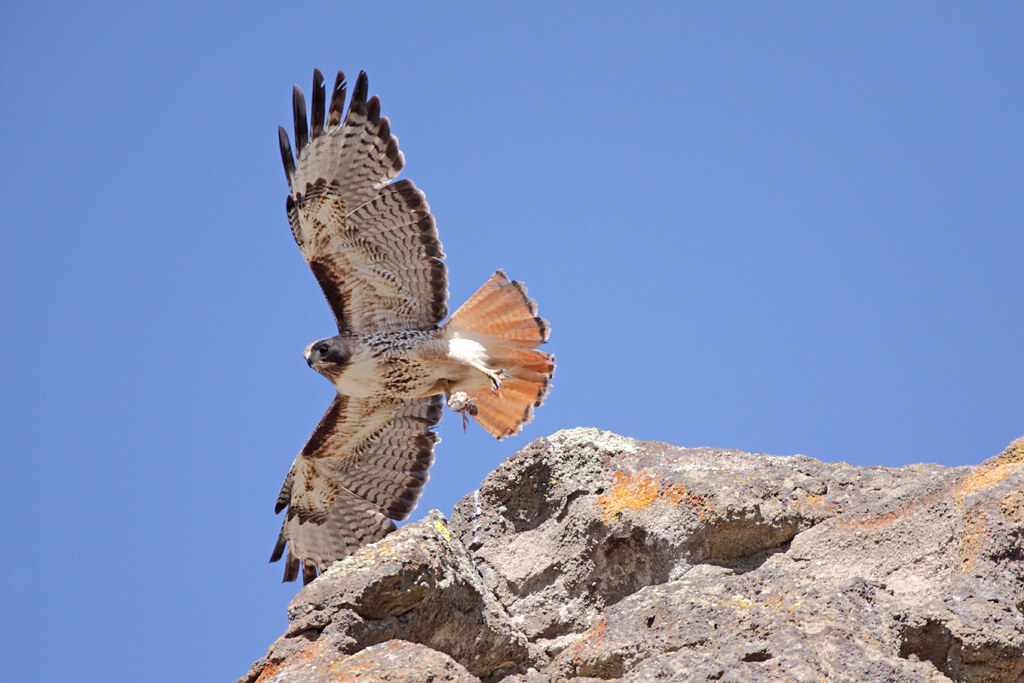
For wildlife enthusiasts hoping to observe North America’s dominant raptors in their natural habitats, developing basic identification skills can greatly enhance the experience of spotting these magnificent birds. Silhouette recognition represents one of the most useful skills for raptor identification, as each group displays characteristic shapes in flight—buteos like Red-tailed Hawks show broad wings and short tails, accipiters like Northern Goshawks have short wings and long tails, and falcons display pointed wings. Seasonal migration concentrations provide exceptional viewing opportunities, with renowned hawk watching sites including Hawk Mountain in Pennsylvania, Cape May in New Jersey, and the Florida Keys all hosting thousands of migrating raptors during spring and fall movements. Urban environments increasingly offer excellent raptor viewing opportunities as species like Peregrine Falcons and Red-tailed Hawks have adapted to city living, using skyscrapers and bridges as hunting and nesting platforms. Numerous raptor centers across North America provide opportunities to view birds up close through educational programs featuring non-releasable individuals that serve as ambassadors for their species, offering wildlife enthusiasts guaranteed sightings while supporting conservation and rehabilitation efforts.
Conclusion: The Future of North America’s Aerial Alphas
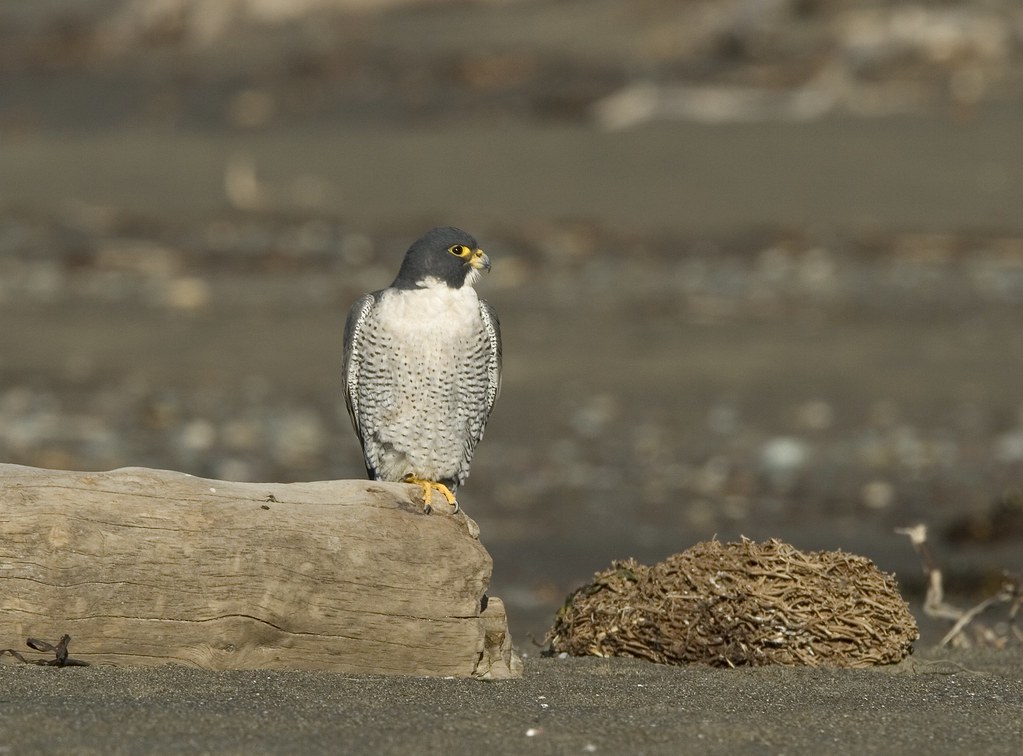
The seven dominant raptors of North America represent some of the continent’s most remarkable wildlife success stories, having overcome serious threats to their survival through a combination of their own adaptability and human conservation efforts. As environments continue to change through climate shifts, habitat alterations, and other human-induced changes, these aerial predators face ongoing challenges that will test their resilience. Their future success will depend largely on continued conservation attention, including habitat protection, reduced contamination from environmental toxins, and management approaches that recognize their ecological importance. The recovery of species like the Bald Eagle and Peregrine Falcon demonstrates that targeted conservation efforts can reverse even dramatic population declines, providing hope for addressing current and future threats. By maintaining healthy populations of these apex aerial predators, we not only preserve iconic wildlife that has captivated human imagination for centuries but also protect the ecological functions they perform across North America’s diverse landscapes. Through ongoing research, conservation, and public engagement, we can ensure these magnificent aerial alphas continue to rule North American skies for generations to come.
